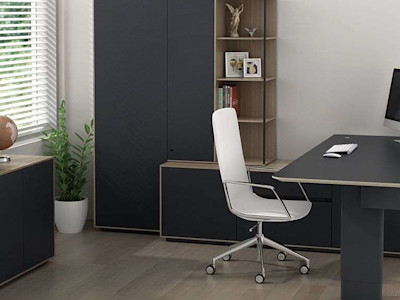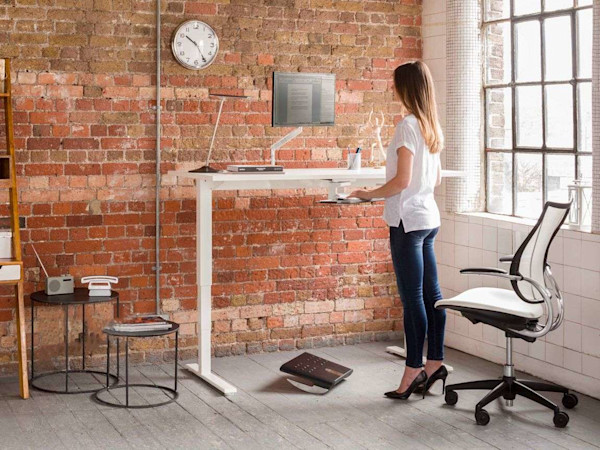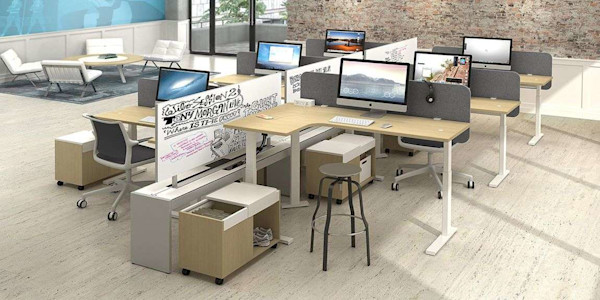How Adjustable Height Desks Have Changed

updated October 2020 Not that long ago, sitting at a desk symbolized that you’d made it to the top. Your desk was outfitted with a tidy ink blotter, a crisp paper calendar, and a telephone that lit up when you had multiple calls. Those Mad Men days are long gone along with the bar cart in the corner of the office. Now we use our cell phones for texting and planning, rarely to make a call, and standing to work is the hallmark of a healthy work environment. Standing at your desk actually isn’t a new idea, though it’s taken time for it to catch on as an acceptable option for increased productivity. Recognizing the creatives juices flowed more freely from an upright position, Da Vinci used a standing desk to create many of his masterpieces, including the Mona Lisa. In fact, in 1797 the Presbyterian minister Job Orton advised, “A sedentary life may be injurious. It must, therefore, be your resolute care to keep your body as upright as possible when you read and write; never stoop your head nor bend your breast. To prevent this, you should get a standing desk.”

>> Order this adjustable height desk for your own office.
Since 70% of people sit to work, it’s not surprising that the havoc wreaked on our bodies from excessive “chair-living” is commonplace. Many of us suffer from coronary disease, obesity, high blood pressure, diabetes, and other chronic illness as a result of our sedentary lifestyle. With the option to move from a sitting stance to a standing position and back again, sit and stand desks afford us the opportunity to increase blood flow and bring an awareness to movement that we might not otherwise cultivate during the workday. Other benefits of switching to an adjustable height desk include:
Increased heart rate by 8 beats per minute, resulting in weight loss and burning calories.
Studies have shown that working at a stand-up desk minimizes fatigue, depression, and tension, as well as increases focus, energy, and overall happiness.
Reduced back and neck pain
Decreased risk of heart attack and heart disease
Better posture and increased core strength
Historically, sit and stand desks were cumbersome hand cranked pieces of furniture. By the time Thomas Jefferson used one in the 1700’s, it was a six-legged “tall desk” with an adjustable slanted top that was large enough to place a folio. Ernest Hemingway employed a modest bookshelf in the 20th century as his sit and stand desk that according to his editor Charles Scribner was “...covered with stacks of letters, magazines, and newspaper clippings, a small sack of carnivores’ teeth, two unwound clocks, shoehorns, an unfilled pen in an onyx holder, a wood carved zebra, warthog, rhino and lion in single file, and a wide-assortment of souvenirs, mementos and good luck charms.”

>> Increase blood flow and improve the health of your employees with this adjustable height desk.
These days, adjustable height desk choices are sophisticated and varied. Push button technology powers them up and down and they are outfitted with customizable storage space. Their evolution has seen upgrades in ranges of styles of finishes, tabletop shape options, meeting tables, and even occasional tables. And there are now social distancing screens to create more privacy, whether standing or sitting. The option used to be "go stand at any of these open standing desks in the bullpen." Now there are designs that can create beautiful and cutting edge personalized workstations that feel private while maintaining an open office design. The height of privacy screens has changed, too, to allow for more flexibility and creating mini, semi-private offices with ergonomics in mind, rather than one-size-fits-all slim cubicles. See how our collection of ergonomically designed adjustable height workstations and sit-to-stand desks can create a more flexible and modern atmosphere for anyone and everyone in your office.



